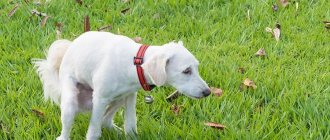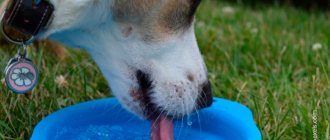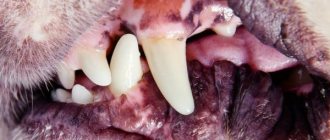Parvovirus enteritis in dogs of the second type (canine parvovirus, parvovirus infection, infectious enteritis) is an acute, highly contagious (contagious) viral disease characterized by high mortality among sick animals. After entering the dog's body, the virus attacks rapidly dividing cells in the mucous membranes of the gastrointestinal tract. Parvovirus also attacks immune blood cells (lymphocytes and neutrophils), causing a corresponding weakening of the immune system.
The disease most often affects puppies between six and twenty weeks of age and older animals, as these age groups have the weakest immune response to the introduction of the virus. In addition, in young animals, the immune system is most severely and often affected and the disease in most cases develops into the cardiac form. Even after successful treatment, cardiac consequences of enteritis in dogs may remain for the rest of their lives, which developed against the background of acute myocarditis (inflammation of the heart muscle).
Parvovirus infection in dogs is characterized by high mortality, and even correct, timely treatment in a veterinary clinic does not guarantee a favorable outcome.
Characteristics of parvovirus
The exact origin of canine parvovirus is unknown; it is believed to have arisen from feline panleukopenia virus (not scientifically proven). It is a non-enveloped, single-stranded DNA virus that is resistant to many common disinfectants and a wide range of temperatures and pH. The infectious virus can survive indoors at room temperature for two months. Outdoors, as long as it is kept out of direct sunlight and kept dry, it can survive for many months and possibly years.
Today, veterinary virology distinguishes two types of parvovirus that can infect dogs:
- Parvovirus type 1 is CPV1.
- Parvovirus type 2 is CPV2.
It is CPV2 that causes the most serious course of the disease and affects not only domestic dogs, but also wild canines. In turn, parvovirus enteritis of the second type may consist of the following types of virus:
- The classic parvovirus type 2 is CPV-2.
- CPV-2a.
- CPV-2b.
- CPV-2c.
Antigenic models 2a and 2b are quite similar to each other and to classical CPV-2. Option 2c has a unique antigenic pattern, which allows it to be distinguished from other types, but the manifestation of the disease is the same in any case. However, differences in the structural pattern of the 2c variant of parvovirus raise suspicions that vaccination in dogs is ineffective. This was thought for some time until studies showed that existing vaccines based on parvovirus type 2b provided an adequate level of protection against parvovirus 2c.
Which dogs are more likely to become infected with parvovirus enteritis?
Puppies aged from 6 weeks to 6 months that have not been vaccinated at all, or the vaccination process was carried out in violation of the regulations, are more susceptible to canine parvovirus infection. Vaccination of the mother at an early age is important for puppies.
When it comes to dog breeds, those most at risk of contracting parvovirus are:
- Rottweilers.
- Dobermans.
- American Pit Bull Terriers.
- English Springer Spaniels.
- German Shepherds.
- Labrador retrievers.
- American Staffordshire Terriers.
In addition, most members of the canine family - wolves, foxes and other animals - are infected and transmitted.
By receiving a sufficient amount of mother's milk, puppies born from a timely vaccinated mother are protected from infection during the first few weeks of life. However, susceptibility to infection gradually increases as the resistance of maternal antibodies obtained in milk weakens. In addition, enteritis in puppies often develops due to weakened immunity due to stressful events, for example, due to weaning, a large number of brothers and sisters in the litter, malnutrition and other factors.
As a rule, in such puppies, enteritis is aggravated by simultaneous intestinal diseases or pathogenic infection. This list of diseases often includes clostridiosis, campylobacteriosis, salmonellosis, giardiasis and coronavirus infection. All these diseases are characterized by a more severe clinical manifestation of parvovirus infection.
As for adult animals, among dogs older than 6 months of age, males are more often affected. In dogs older than 7 years of age, parvovirus actively develops due to weakened immunity with age.
Parvovirus infection is the most common autumn-spring disease in dogs.
The most common fall-spring disease in dogs is parvovirus infection. In Krasnogorsk and Istra districts, cases of this disease have increased by 50%.
Canine parvovirus infection (or canine parvovirus enteritis) is a contagious disease manifested by debilitating vomiting, hemorrhagic gastroenteritis, leukopenia (decreased white blood cells), dehydration (dehydration) and death of puppies under 5 months of age.
Source of infection. Infection with the virus occurs through the oral-fecal route, because the virus persists in the environment for years and is resistant to many disinfectants, the disease is widespread, thus the risk of infection is very high, without requiring direct dog-to-dog contact.
Animals in nurseries, pet stores, poultry markets, and shelters are predisposed to developing parvovirus infection. Even vaccinated pets can get sick, especially puppies in the period between the first vaccination, so you should observe the quarantine recommended by your doctor for puppies, keep them away from your shoes (as the owner can bring the virus from the street), and adult dogs should be warned against eating the feces of other animals.
Clinical signs.
The sensitivity of dogs to this disease depends not on gender and breed, but on age. Puppies 0-5 months of age get sick and die more often. Their mortality rate can reach 80%. Among adult dogs, mortality is possible up to 16%.
The incubation period lasts up to 4-14 days. The form of the disease varies in dogs of different ages. This is explained by the fact that parvovirus predominantly multiplies in actively dividing cells (i.e. in a young animal).
The first clinical signs are: vomiting, diarrhea with a foul odor (the color may also change from brown to green, as well as the presence of blood particles in the stool).
Diagnostics. The diagnosis is made based on the owner’s story about the animal, how its condition has changed and how it all began, and a clinical examination of the animal. The diagnosis is confirmed based on a PCR stool analysis, a rapid test during the initial appointment, and a general blood test.
Treatment. Symptomatic treatment is prescribed aimed at improving the functioning of the gastrointestinal tract, replenishing fluid volume (droppers), antibacterial and antimicrobial therapy, antiemetics, and immunomodulatory therapy. In severe cases of the disease, hospital treatment and daily monitoring of the animal are recommended.
Only a doctor can prescribe treatment! Do not self-medicate over the Internet. If treated incorrectly, you can harm your pet, and the outcome of the disease can be fatal.
Immunity and specific prevention.
Animals that have recovered from the disease develop strong immunity, the approximate duration of which is 3 years.
Prevention of disease. It is necessary to completely disinfect the premises where the animal was located; it is advisable to dispose of bowls and bedding. Clean up the animal's feces and dispose of it within several months after the illness (since the animal can remain a virus carrier for up to a year).
In the future, it is necessary to comply with the annual vaccination of the animal, even if you have a small decorative dog that does not walk outside. Always remember, when you go outside you can be a carrier of the disease!
Infection of dogs with parvovirus infection
Parvovirus is released in high concentrations into the external environment with the feces of infected animals 4-5 days after infection, that is, before the first symptoms of enteritis appear in dogs. Virus shedding continues throughout the entire period of illness and for approximately another 10 days after clinical recovery.
Parvovirus infection enters healthy dogs through direct oral or nasal contact with contaminated feces. In addition, indirect infection is possible through contact through household items, the owner’s clothing and other objects that could be soiled with the feces of a sick animal.
Parvovirus in healthy dogs initially develops in the lymphoid tissue of the oropharynx with subsequent transition to a system-wide form as a result of spread throughout the body through the bloodstream. The viral infection primarily infects and destroys rapidly dividing mucosal epithelial cells of the small intestine, lymphopoietic tissues (lymphocyte-producing tissues), and bone marrow. From this point on, symptoms begin to develop.
The destruction of intestinal crypts by the virus leads to epithelial necrosis of the mucous membrane (death), villous atrophy, and impaired absorption capacity of the intestine. As a result, these pathological processes lead to the destruction of the functionality of the intestinal protective barrier, which ends with the active penetration of bacteria located in the intestinal lumen into the blood and the development of a secondary infection.
This pattern of enteritis in puppies under 8 weeks of age, as well as in older dogs, can lead to the development of heart infections, inflammation of the heart muscle and myocardial necrosis. Subsequently, myocarditis may clinically manifest as acute cardiopulmonary failure with or without symptoms of parvovirus enteritis. It is worth noting that heart problems are not observed so often in puppies, since their blood contains antibodies against parvovirus obtained from their mother's milk (colostral immunity).
Symptoms of parvovirus infection
In veterinary medicine, three forms of the disease are distinguished: cardiac (myocarditis), intestinal (interstinal) and mixed (combined). The symptomatic picture is largely determined by the type of pathogen that affects the body.
In the cardiac form, virions target cardiac cells. Most often, the disease affects puppies aged 2 weeks to 2 months; young puppies up to 7 months are more rarely affected. In older dogs, the myocarditis form of infection does not occur, since the heart muscle stops growing and is not of interest to the viral particle from the point of view of the target.
Parvoviral myocarditis is a common cause of sudden death in puppies due to acute cardiovascular failure. With a lightning-fast course, symptoms do not have time to develop. In the acute form, puppies experience refusal of food and water, vomiting, shortness of breath, pulmonary edema, and a sharp increase in blood pressure.
Most often in medical practice, veterinary specialists encounter the intestinal form. Parvovirus primarily affects the cells of the digestive tube, causing irreparable damage to the body. With a fulminant course of infection, 90% of cases are fatal among young animals under the age of 2 months. In acute cases with an incubation period of 5 - 7 days, the mortality rate is lower - 60 - 70%.
The interstitial form of the disease is characterized by a serious violation of the absorption function of the intestine. The owner observes profuse diarrhea in his pet. In the early stages of the pathology, feces are gray or gray-yellow in color. As the infection progresses, the color of the stool changes to greenish. There is a large amount of mucus and blood in the stool. A characteristic feature is a foul odor.
Disruption of the digestive system is manifested by uncontrollable vomiting. A rapidly increasing change in the acid-base and electrolyte balance causes dehydration, exhaustion and severe intoxication. Severe dehydration often leads to convulsions, collapse and the development of a state of shock.
The animal does not accept food or water. The lack of thirst is caused by the fact that with catarrhal and hemorrhagic inflammation of the intestinal tube, the dog experiences pain associated with the intake of food and liquid.
Body temperature can reach 41C. In the acute form, as a rule, hyperthermia is insignificant and does not exceed 39.5C.
In the mixed form, the pathogenic microorganism affects several systems - digestive, respiratory and myocardial cells. The clinical picture is varied. The sick individual has vomiting, profuse mucous diarrhea, and blood in the feces. The abdomen is painful and enlarged. From the respiratory system, rhinitis and bronchitis are noted. The inflammation is usually catarrhal in nature.
Bronchopneumonia is often diagnosed. The cardiovascular system reacts to the virus with shortness of breath, anemia of the mucous membranes, and tachycardia. Parvovirus infection in the mixed form is characterized by hyperthermia - the temperature rises to 41C.
Forms and symptoms of enteritis in dogs
The vast majority of cases of parvovirus enteritis in dogs involve the small intestine, with associated symptoms and treatment. Actually, the term “enteritis” means “inflammation of the intestines,” in this sense caused by parvovirus infection. However, as noted above, the manifestation of the cardiac form of the disease is possible, which is relatively common with enteritis in puppies.
Intestinal form of parvovirus infection in dogs
The enteric form of parvovirus is transmitted only through oral contact with virus-contaminated feces of an infected animal or surfaces that may be contaminated with such feces.
In the intestinal form of the disease, the following sequential development of the disease is observed in which parvovirus:
1.Excreted into the environment with the feces of a sick dog.
2.Penetrates into the body of a healthy dog through the oral or nasal cavity.
3.Settles and multiplies in the lymphoid tissue located in the throat of a healthy animal.
4.Spreads into the bloodstream, where it begins to attack immune blood cells, thereby destroying them.
5. Penetrates into the tissues of the bone marrow and lymph nodes, where it begins to destroy the hematopoietic system.
6.Spreads into the cells of the mucous membrane of the small intestine, gradually destroying them, the first symptoms of enteritis in dogs begin to appear, treatment is prescribed. Severe dehydration of the body and associated disturbances in the electrolyte composition of the blood develop.
Parvovirus enteritis in dogs - causative agent, risk group, methods of infection
Parvovirus enteritis is an infectious disease caused by a virus from the parvovirus family PVS-1 and PVS-2. The disease is quite young, first discovered in 1977 in the USA. Parvovirus is believed to have arisen as a result of a mutation of the feline panlecopenia virus.
The disease affects dogs of all ages, but the highest mortality rate is observed among puppies aged 1.5-2.5 months. With age, the risk of the disease decreases. Enteritis is dangerous only for dogs; the disease is not transmitted to humans.
Infection occurs as follows:
- in direct contact with an infected relative;
- when sniffing secretions (feces, urine, saliva) left by a virus-carrying dog;
- through food and water;
- The virus can be carried by the owner of the animal (clothing, shoes).
Consequences of enteritis in dogs
Puppies that survive parvovirus enteritis show the consequences of the growth of fibrous tissue in the myocardium, which is essentially an acquired heart defect that affects the entire future life of the dog.
It is important to understand that an animal that survives parvovirus enteritis in any form will still shed remnants of the virus in its feces for at least 10 days, up to an average of three weeks. Among other things, a dog can become a carrier of parvovirus and from time to time, in the course of its life, release it into the external environment and infect other animals.
Symptoms of parvovirus infection in dogs
Symptoms of parvovirus enteritis in dogs without treatment usually develop within 5-7 days after infection, but this period can range from 2 to 14 days. Initial clinical signs may be nonspecific, such as apathy, lack of appetite, fever, with progression to vomiting and hemorrhagic diarrhea over the next 24-48 hours.
Physical examination findings may include:
- loss of motor activity;
- fever;
- dehydration;
- dilated intestinal loops on ultrasound or x-ray, filled with fluid.
The animal's response to abdominal pain requires further evaluation to rule out the potential complication of intestinal obstruction.
In the most severe cases, non-specific symptoms of parvovirus in dogs may include:
- short-term loss of consciousness;
- pallor of the mucous membranes;
- low pulse quality;
- tachycardia;
- reduced body temperature.
The lack of treatment is due to symptoms of enteritis in dogs in the area of nervous activity, occurring against the background of low blood sugar, general sepsis, disturbances of acid-base balance and water-salt metabolism. It must be remembered that parvovirus infection in dogs can be asymptomatic or subclinical.
At the same time, with parvovirus enteritis, in the predominant number of cases of the intestinal form, the following symptoms are observed:
- Lethargy, loss of playfulness.
- Decreased appetite, up to complete refusal to eat food.
- Uncontrollable vomiting.
- Increase in body temperature by 1-3 degrees. In later stages, the temperature may drop.
- Watery stools with mucus in the early stages of the disease. In the future - diarrhea with blood.
- Severe depression and exhaustion of the animal, often with signs of cardiac, respiratory failure and general bacteremia.
The appearance and progressive development of these symptoms is the reason for an urgent visit to a veterinary clinic. These symptoms do not always appear due to parvovirus enteritis in dogs, however, untimely treatment can lead to an unfavorable prognosis.
Signs and symptoms of parvovirus
If a dog is infected with parvovirus, the first signs usually appear three to ten days after infection. This period is called incubation. Common symptoms your puppy may experience are:
- Severe lethargy
- Vomit
- Diarrhea or diarrhea (usually bloody)
- Heat
With parvovirus enteritis, dogs become severely dehydrated. The virus can also damage cells in the animal's intestinal wall, causing life-threatening complications such as a low white blood cell count (leukocytpenia), severe systemic inflammation (sepsis), and a low red blood cell count (anemia). If you suspect that your dog has contracted parvovirus, you should take him to your veterinarian as soon as possible. In this case, time is one of the most important survival factors.
Treatment of enteritis in dogs
One of the few drugs for the specific treatment of parvovirus enteritis is polyvalent serum against canine distemper, parvovirus and coronavirus enteritis and adenoviral infections of dogs - Giskan-5 (Russia) Vaccines and biological products.
The only effective way of prevention is to vaccinate dogs, starting from puppyhood. You can use multicomponent vaccines produced in: Russia - Multikan-8, France - Eurikan or Holland - Nobivak.
The types of vaccines used, their antigenic composition and cost are indicated in the Vaccines and Biological Products section.
Time is one of the most significant factors in the treatment of enteritis in dogs, at the first symptoms of the disease. The sooner the virus is detected and treatment begins, the better the prognosis. Age also plays an important role in the effectiveness of parvovirus therapy. Extremely young or old dogs will not be able to withstand more aggressive treatments aimed at eradicating parvovirus infection.
It is worth emphasizing that treatment of enteritis in dogs at home in the vast majority of cases will not result in the animal’s recovery. The basis of parvovirus therapy is laid in the form of a comprehensive use of symptomatic treatment and maintenance of the body:
- Intravenous drip administration of type IV crystalloid solutions or classical colloids.
- Use of injections of antiemetics.
- Intravenous administration of antibiotics.
- The use of additional means that support the animal’s life support - vitamins, glucose, saline solutions, immunostimulating drugs and others.
Since absorption processes in the small intestine are almost completely impaired, treatment of enteritis in dogs is based on an assessment of symptoms and, as a rule, using intravenous, intramuscular and subcutaneous injections. The use of such a complex combination of drugs and methods of their administration at home is impossible without certain skills of the owner.
After initial treatment for parvovirus, dogs will be restricted from taking additional fluids, but only if their blood is hydrated (determined only by biochemical testing). Life support will be maintained with easily digestible food in semi-liquid form. The use of antibiotics usually continues after the first signs of recovery begin to appear in dogs whose blood picture shows a low white blood cell count. This option is necessary because the animal’s immune system is very weakened by parvovirus and death can occur at any time due to the development of a secondary infection.
How to protect your pet - prevention of enteritis in dogs
Since the causative agent of parvovirus infection in dogs is stable in the external environment, and the disease is characterized by a high rate of development of life-threatening symptoms, it is extremely important for the owner to know the basic points that will help prevent infectious enteritis in his dog.
Vaccination of puppies
This method is considered the most effective in preventing the disease. The domestic industry produces several versions of vaccines, which must be used in accordance with their instructions. Of the budget, but no less effective vaccines, the most commonly used are:
- Culture-inactivated vaccine against parvovirus enteritis in dogs.
- Multikan-4, which includes the prevention of not only parvovirus infection in dogs, but also distemper, adenovirus infection, and coronavirus enteritis.
- Multikan-8 - in addition to the above diseases, includes the prevention of leptospirosis and rabies.
Infected dogs can spread enormous amounts of parvovirus, making it very difficult to treat dog areas. The tiny parvovirus is extremely resilient. It is able to survive for several months outside the animal's body, even surviving the winter. In addition, the pathogen is not susceptible to most household chemicals, which are often used for disinfection.
If the territory of an apartment or yard is contaminated by an infected dog, regardless of whether it died or recovered, disinfection of the places where it is kept must be carried out in any case. Especially if you need to get a small puppy. Despite its relative resistance to chemicals, canine parvovirus is actively killed by exposure to conventional chlorine-containing bleaches. Cleaning the living area with a solution of one part bleach mixed with approximately 30 parts water is an acceptable method for treating any surfaces that the sick dog has come into contact with. Moreover, this approach is safe for the people around you and the future little puppy.
What is parvovirus in dogs
Parvovirus is a dangerous infectious disease of viral etiology, caused by an infectious agent from the parvovirus family (Parvoviridae).
The epithelium of the small intestine, bone marrow and heart muscle are especially sensitive to the pathogen.
In nature, there are two types of canine parvovirus (Canine parvovirus, abbreviated as CPV): types 1 and 2. The first is not pathogenic for canids.
The danger is posed by Canine Parvovirus type 2, a small DNA-containing virus without an envelope. At low temperatures, the pathogen remains infectious for several years. Dies when treated with formaldehyde or 30% soda ash solution.
Parvovirus type 2 causes myocarditis or gastroenteritis in dogs. The second form of pathology is the most common.
Common forms of parvovirus infection
Parvovirus enteritis most often manifests itself in intestinal and myocardial forms, multiplying in myocardial cells and intestinal epithelium. In adult dogs, such cells multiply less actively than in puppies, so the course of the disease is asymptomatic in some cases. Moderate or severe manifestations are rare. In puppies, the number of such cells increases quite quickly, so they are more susceptible to severe disease. In young puppies, cardiomyocytes multiply rapidly, but the reproduction of epithelial cells in the intestines is not yet so active. In older puppies, on the contrary, epithelial cells in the intestines multiply more intensively, and myocardial cells more slowly. Due to the peculiarities of the functioning of the body of puppies at suckling age, they more often develop the myocardial form of parvovirus enteritis, and after weaning from the mother, the intestinal form.
How does infection occur?
The greatest danger of infection is through direct contact with a sick animal. After infection, an infected dog excretes millions of viruses through diarrhea and vomiting for 2-3 weeks. The virus can be transmitted through objects in the external environment - carried on clothing, human shoes, transmitted through toys and other things. Parvovirus is very resistant, does not collapse when frozen, and can withstand temperatures up to +100° C for quite a long time (up to 3 days).
In adult dogs, the incubation period (the time from the moment of infection to the appearance of the first clinical signs) can last 4-10 days; in puppies aged 1-2 months, clinical signs appear already on the 2-3rd day and due to their very small body weight they have the highest percentage of deaths from the disease.
Symptoms of the disease
Clinical manifestations of the disease occur suddenly. There is a loss of appetite, short-term fever, vomiting, and a decrease in the number of urinations. The pet's abdomen sometimes becomes tense and sensitive to palpation. Vomit may contain mucus and bile. About a day after the first symptoms appear, diarrhea appears. Feces have a foul odor and may contain blood. The color of stool can be green, bright purple, yellow, dark red, or black. Vomiting accompanied by diarrhea quickly leads the animal's body to dehydration. Signs of dehydration include deepening of the eyeballs and folds of the skin. In adult dogs, the disease occurs in a subclinical form and is accompanied by loss of appetite, depression of general condition, and rarely, gastrointestinal upset. The nature of the course of the disease is influenced by the amount and virulence of the virus that has entered the body, the general state of the pet’s immunity, the presence of helminths, and the presence of stress in the animal’s life. Therefore, it is important to take care of the dog, vaccinate it in a timely manner, and give it anthelmintic drugs. One of these products is the Dironet suspension. It can cope with the most common parasites. The length of time the mother feeds the puppy also affects the manifestation of symptoms. With mother's milk, he receives a certain amount of antibodies, which will allow him not to get sick or to transfer this virus in a milder form. Animals that have recovered from parvovirus enteritis develop immunity.
Diagnosis of the disease
A preliminary diagnosis is made on the basis of clinical signs, such as sudden vomiting, dehydration, characteristic type of bowel movements, etc. Epizootological data in the area where the pet lives is analyzed. An accurate diagnosis is established based on laboratory tests. A common method for such studies is to detect viral DNA in the stool of a sick dog, taken at the peak of the disease. Special rapid tests are also widely used, with which you can quickly confirm the diagnosis.
Diagnostics
The diagnostics carried out must be comprehensive. The diagnosis is made based on history, clinical signs, epidemiological data and laboratory data.
Affected animals experience leukopenia due to damage to lymphoid tissue, red bone marrow and migration of mature neutrophils into the inflamed intestinal mucosa. Due to the development of hemorrhagic enteritis and, as a consequence, gastrointestinal bleeding, diarrhea and vomiting, puppies may experience varying degrees of anemia, thrombocytopenia and a decrease in hematocrit. Specific findings encountered during the interpretation of biochemical studies of blood serum include hypoalbuminemia, hypokalemia, hyponatremia and hypochloremia.
The final diagnosis is made after identifying the Ag viral protein in a PCR reaction, ICA or determining the antibody titer by performing an ELISA.
Treatment of parvovirus enteritis
Only a specialist can carry out competent treatment, so when the first alarming signs of the disease appear, we advise you to contact a veterinarian. It is important to diagnose the disease at an early stage. Polyvalent hyperimmune serum against parvovirus enteritis and polyvalent immunoglobulin can help at the very beginning of the disease; using them after 3 days is useless. Simultaneously with the use of specific agents, symptomatic therapy is prescribed, aimed at eliminating vomiting and diarrhea. Measures are being taken to combat dehydration and infusion therapy. During the treatment process, a diet must be followed and vitamin therapy is used. A proper rehabilitation period, a gentle diet at this stage and a gradual return to a normal diet are very important for the animal.
Prevention of parvovirus enteritis
Timely vaccination of an animal is the most effective measure to prevent the disease. It would be rational to vaccinate the expectant mother several weeks before the planned mating. In this case, the puppies will receive a certain immunity from their mother's milk; it will remain in their body for about 4 weeks. If the risk of contracting parvovirus is high, puppies can be vaccinated early, but strictly under the supervision of a veterinarian. Our country uses domestic and imported vaccines against parvovirus enteritis; this disease is included in the complex of main polyvalent vaccines.
Parvovirus in dogs is a disease that is exclusively infectious viral in nature, and is also one of the most life-threatening for an animal and very difficult to cure. This is due to the fact that this virus adapts very well to a variety of conditions and survives quite well in them.
Also, parvovirus, for the most part, very strongly affects puppies, this also occurs due to the fact that the immune system of young dogs is not yet strong enough and cannot fully provide an immune response to the insidious infection.
Main characteristics of parvovirus
As for the first cases of animal infection with parvovirus infection, they almost all ended in death, but today, for the most part, puppies aged from six weeks to six months suffer from this disease.
As for adult dogs, in most cases they develop stable immunity to infection. This usually occurs as a result of vaccination or after suffering from a form of this disease.
After the puppy is born, the mother also transfers part of her immunity to him, but as a rule, such an immune response is not long-term. After six weeks, the immune system begins to weaken and the puppy can easily become infected with a disease such as parvovirus.
As for other factors that can cause parvovirus in dogs, they are mostly the following:
- persistent stressful situations of the animal;
- animal uncleanliness;
- poor living conditions;
- helminthic infestations;
- a variety of primary viruses and bacteria that significantly reduce immunity;
- genetic predisposition;
- certain breeds of dogs that are most susceptible to the effects of this virus.
As for the main method of transmission of this infection, it is mostly transmitted from a sick animal to a healthy one, both by airborne droplets and by feces.
Parvovirus is a disease whose treatment is quite complex and the virus is also very stable and can maintain its vital activity for several years.
Infection of an animal in most cases occurs through contact of the dog with a contaminated surface. Thus, it is very difficult to destroy viruses, since they can be located almost everywhere, and disinfection must be carried out exclusively with bleach, since other disinfectants do not eliminate this virus.
The main symptoms of parvoviruses include that their incubation period generally lasts about seven days, although in some cases this period can be longer or shorter. It is also worth noting that not all animals, after contact with a viral infection, can immediately become infected with its active form.
The main symptoms in young puppies may be as follows:
- sudden death;
- diarrhea due to intestinal tissue dying;
- septic shock (blood poisoning);
- complete dysfunction of all organs;
- death.
Are you here
Description and pathogen
Canine parvovirus is a viral, highly contagious (contagious) disease of dogs, characterized primarily by damage to the gastrointestinal tract and high mortality in young unvaccinated animals; infection of newborn puppies can lead to damage to the heart muscle (myocardium) and death of the animal.
The causative agent of canine parvovirus infection is a DNA-containing virus of the parvovirus family; in the United States, the most common causative agent of canine infection is its subspecies CPV-2b. The virus is excreted in significant quantities in the feces of sick and recovering animals, and is characterized by fairly high resistance in the external environment. Infection of susceptible dogs most often occurs not through direct contact with a sick animal, but through various inanimate objects (eg the animal owner’s shoes). From the moment a dog is infected with parvovirus until the development of clinical signs, an average of 2-5 days pass (incubation period).
Canine parvovirus tends to infect young dividing cells of the body, especially the cells of the inner wall of the intestines and bone marrow. Damage to the cells of the intestinal mucosa leads to its severe damage, the leakage of important components of the body from the blood into the intestinal lumen and the absorption of toxins from the intestines, all this is accompanied by severe vomiting and diarrhea, most often mixed with blood. The infection of bone marrow cells by canine parvovirus leads to disruption of the production of leukocytes, which are responsible for a complete immune response, this deprives the body of the ability to respond normally to a viral infection.
Synonyms: canine parvovirus infection, canine panleukopenia.
Clinical signs
The severity of clinical signs of parvovirus infection depends on the age of the animal and its vaccination status, namely: canine parvovirus in newborn puppies can be accompanied by heart damage and rapid death without pronounced clinical manifestations; parvovirus infection in young unvaccinated puppies is accompanied by debilitating bloody vomiting and diarrhea; in animals about a year old or timely vaccinated puppies, parvovirus infection may not appear at all, or may be accompanied by short-term digestive upset; In animals older than one year, parvovirus infections are practically not recorded, with the exception of dogs with a compromised immune system. The severity of canine parvovirus may also be related to the breed of the animal and be accompanied by increased mortality, this phenomenon is observed in breeds such as the Rottweiler, Doberman Pinscher, American Pit Bull Terrier and German Shepherd.
The classic sign of canine parvovirus and the reason for contacting a veterinary clinic is depression of the animal, refusal to feed, uncontrollable vomiting and bloody diarrhea with a characteristic odor. If an animal with parvovirus is not treated, it will develop signs of dehydration - sunken eyeballs, dry mucous membranes of the mouth and loss of elasticity of the skin.
Features of diagnosing infection
The most basic symptom of parvovirus infection is uncontrollable diarrhea mixed with blood. The virus is very difficult to classify, since almost all of its symptoms can be observed in the presence of other similar diseases. This is due to the fact that some manifestations of infection are very common when a dog’s body is affected by parasites and other infectious processes.
Thus, in order to identify the presence of the virus in an animal, it is necessary to carry out a series of laboratory tests, however, in this case it is worth noting that during this period the animal must be strictly isolated, since it continues to excrete infected feces into the environment, which can be the main cause of infection in other dogs.
Cure parvovirus
Modern treatment of this infection does not provide any special techniques. This is due to the fact that it simply does not exist. In most cases, special therapy is used, which is aimed at maximally supporting the puppy’s body and its immune system so that it can itself inflict a strong immune response to this pathogenic pathogen.
The dog must be isolated, and the room where it is located must strictly undergo all proper treatment using special disinfectants.
In order to properly treat a dog, it is worth regularly making intravenous drips, which will maximally saturate the pet’s body with useful nutrients. Also, with the help of droppers, the body is flooded, which is very effective for indomitable diarrhea and, as a result, dehydration of your pet’s body.
If a puppy has very persistent anemia, which can lead to a very large number of complications and death, then in this case a procedure such as a transfusion of donor blood from another pet is indicated.
In order to most effectively alleviate the condition and exclude the development of a secondary bacterial infection, in most cases the dog is prescribed special antibacterial agents. It is also necessary to restore the intestines using a variety of intestinal remedies. Thus, it is worth saying that as soon as you observe any changes in the behavior or condition of your pet, you should definitely consult a veterinarian who will conduct all the necessary examinations of your pet and prescribe adequate treatment, which will be aimed at restoring the animal’s body.
Also, do not forget about carrying out adequate immunotherapy. This is necessary so that the pet’s body can cope with the virus on its own and be completely cured.
Basic preventive measures
Initially, it is worth saying that if a pet has had parvovirus, then it retains fairly stable secondary immunity. However, it does not persist throughout life. Thus, it is worth noting that the most effective way to avoid infection is timely immunization of the animal. Vaccinations must be carried out strictly in accordance with the recommendations of a veterinarian, since timely vaccination is the real guarantee of your dog’s health.
Also, it must be said that when a puppy is born, it receives a certain amount of antibodies from its mother. This transfer is carried out through natural feeding of the puppy. However, this immunity lasts no more than six weeks, after which it is worthwhile to vaccinate the dog as necessary.
The second option for developing immunity in a puppy is the introduction of special antibodies through a vaccine. However, it is also worth noting that persistent production of these antibodies by organisms is observed after the second vaccination, therefore, the chances of becoming infected with parvovirus in a dog are significantly reduced.
How to identify the disease?
Signs of parvovirus in dogs do not have specificity, by which one can say for sure - yes, it’s him and no one else. Rather, all the symptoms are acute indicators of a pet’s illness, and an accurate diagnosis can only be made by a doctor who tests the animal’s blood and feces. But still, the main symptom of parvovirus in dogs is colored diarrhea, which is usually accompanied by vomiting, fever, general lethargy, apathy, refusal to eat, fever, and frequent urination.
IMPORTANT: the symptoms of parvovirus are often confused with distemper, so do not self-medicate, but immediately take the animal to a specialist. Both diseases can only be diagnosed after laboratory testing of stool and urine samples.
But all the bright external symptoms appear only if the virus has entered the gastrointestinal tract, and if it first affects only the heart muscle, then the dog’s behavior changes as follows: depressed state, difficulty breathing, weak pulse, heart attacks. Puppies tolerate this form extremely hard and in 50% of cases die from a heart attack even before diagnosis.
What may be the outcome of the disease in dogs?
Once an animal has become infected with parvovirus, there may be several options for the outcome of this infectious disease:
- If the disease is mild, then in an adult the recovery occurs in about two days.
- If the dog’s condition is serious, then it is worth urgently hospitalizing it and taking all necessary measures aimed at completely restoring the animal’s immune system and maintaining the entire body as a whole. If all measures are taken correctly, the animal will feel some relief after about five days.
- If a dog experiences a very severe form of a viral infection, which is accompanied by bloody diarrhea and uncontrollable vomiting, then most such cases end in death for the animal. It is also worth noting that death can occur on the very first day of the disease. This form mostly affects small puppies whose immunity is not yet strong enough.
Thus, parvovirus is an insidious disease that requires timely vaccination of dogs.










